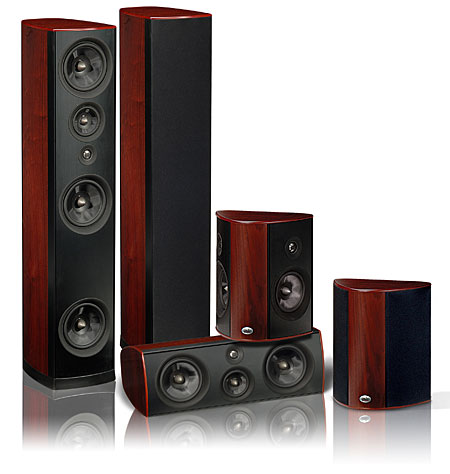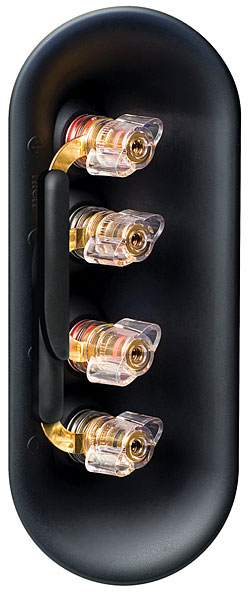PSB Synchrony One Speaker System

So when a company like PSB launches a new line of high-end speakers, audiophiles take notice. The new Synchrony line, which includes seven models, may be one step down from the flagship Platinum range in PSB's product hierarchy, but it's as up-to-the-minute as the company can make it.
Features
The Synchrony One sits at the top of the line. Its three 6.5-inch woofers combine rigid, low-mass cones of laminated fiberglass and compressed felt with low-distortion voice-coil assemblies and cast-aluminum baskets. Each woofer is separately enclosed and separately ported. They are widely spaced along the front baffle to help control floor bounce (the "Allison effect"), which often results in uneven midbass response from otherwise good speakers in a typical listening room. The One's 4-inch midrange driver, which has the same design features as the woofers, is isolated from the rest of the drivers in its own sealed chamber.
The 1-inch titanium-dome tweeter has evolved from PSB's previous tweeter designs. It employs ferrofluid cooling in the voice-coil gap and a computer-optimized, neodymium magnet.
One of the unique aspects of PSB's design is its cabinet construction. The front baffle is composed of two layers of extruded, black-anodized aluminum separated by a layer of vibration-damping material. The curved, veneered, seven-layer side panels lock into the front and back, which is also an aluminum extrusion.
The perforated-metal/cloth-covered grilles fit tightly into narrow slots at the sides of the front baffle. I preferred the sound with the grilles removed, but they fit so tightly that I thought they were permanently attached at first. Fortunately, PSB includes a small tool that lets you poke through the cloth and one of the holes in the perforated metal, get a grip on the grille, and pull it off easily without damage. But the outer half-inch or so of the metal grille has no perforations, so the tool won't work there!
 The back of the cabinet sports the three bass ports and two sets of high-quality binding posts. These posts are designed to accept all the most common speaker connectors, plus bare wire up to 10 gauge. "Wings" on the sides of the connecting posts permit easy hand tightening. The dual terminal pairs allow bi-wiring with the removal of shorting straps.
The back of the cabinet sports the three bass ports and two sets of high-quality binding posts. These posts are designed to accept all the most common speaker connectors, plus bare wire up to 10 gauge. "Wings" on the sides of the connecting posts permit easy hand tightening. The dual terminal pairs allow bi-wiring with the removal of shorting straps.
The single-port Synchrony One C center speaker and sealed-box Synchrony S surrounds are similar to the Synchrony One in their cabinet and driver designs. The One C is a 3-way system, with the midrange and tweeter oriented vertically between dual woofers.
The surrounds can be wired in one of three different ways: as conventional bipole surrounds with the front- and rear-facing drivers operating in phase, as conventional dipole surrounds with the fronts and rears out of phase, and with the front- and rear-facing drivers powered separately.
These options provide several setup options—first, as conventional sidewall surrounds, wired either bipole or dipole in a 5.1-channel system. Alternatively, you can wire the two sets of drivers separately in a 7.1-channel configuration, with the front-facing drivers driven by the side-surround amps and the rear-facing drivers by the back-surround amps. You could also use a third Synchrony S for the center-back surround in a 6.1-channel system or wire its drivers separately to serve two rear channels. Or you could go with second pair of Synchrony Ss for the two back channels in a discrete 7.1-channel system, with the drivers driven either bipole or dipole. The mind boggles at the variations.
There is no PSB subwoofer specifically designed for the Synchrony line. To fill this gap, PSB sent me the SubSeries 9. Mid-sized as subwoofers go, the SS9 employs two 10-inch drivers, one in the front of the cabinet, the other in the rear, driven by a 350W (continuous) Class H, MOSFET amplifier. The positioning of the drivers is said to dramatically reduce cabinet vibration, since their cone movements nullify each other. The sub offers the usual controls: Power, Volume, Crossover, Crossover Bypass, and Phase (0 and 180 degrees). Connections include low-level (line) and speaker-level inputs, plus low-level outputs (always full range).
- Log in or register to post comments




































































